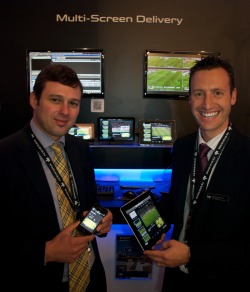
EVS has introduced a new concept, Sports360, covering all aspects of sports media from live broadcasting to archive and new media distribution, to make it simpler to reach viewers wherever they are (and whatever type of screen they are using). David Fox talks to EVS about its gestation and objectives.
EVS’ new Sports360 aims to help content owners, broadcasters and facility companies to address multiple markets at once and cope more easily with the partitioning of rights for different platforms. Although “there is more and more distributed media available to broadcasters and producers”, EVS’ Marketing & Communications Director Nicolas Bourdon sees a clear risk that by limiting viewers to watching just a director’s cut on the TV screen will cause broadcasters to lose a considerable part of an audience that increasingly turns to a second screen to check in on Facebook or Twitter and may stop watching TV.
“We are creating a massive amount of content on our servers, so we wanted an alternative way of providing complimentary content on second screens,” he said.
To enable this, it has developed C-Cast (for cloud-cast), which allows broadcasters to make highlights and clips available over a web server and delivered through the cloud to user’s iPads or any other web-connected device. This means that if there is any interesting action, such as a goal or a red card, within two minutes users will be able to access alternative content related to this, such as viewing the incident from different camera angles.
Its 360 concept starts with the live production and endeavours to build on what is already being done for the broadcast, giving producers the ability to create and deliver, in parallel, near-line media to different platforms, using C-Cast.
The third part of the equation is the provision of systems that simplify getting media to studios or media hubs, for compilation in to highlights packages or news stories by journalists or post production. “The last step is the interaction with the archive, so broadcasters can monetise their content, which would be used during live or near-live production, such as to create stories about specific players and for viewers to access further related content from the archive,” he explained.
It also makes it easier for logs and associated metadata to be included with the archive during automated digitising.
All four parts are available now, with parts one and three (live production and Sport Broadcast Centres) now in operation, with many users like the BBC, Sky Sports, NBC, Fox, and Canal+ already using this workflow. It requires integrated solutions in addition to the EVS servers, such as IPDirector for content management, XStore near-line storage, or advanced media handling tools. Although designed primarily for sports production, the system could also have applications in any other type of live or near live programming.
To support Sports360, EVS is offering: enhanced live production with high-end replays, on the fly editing, new ultra motion control capabilities, overlay graphic analysis or 3D replay and super-motion operations; sports highlights and immediate media access and exchange with post production; logging and statistics integration; mobile, web streaming and multi-channel delivery; second screen applications; and sports archive management
.
Version one of C-Cast has recently been released, and is due to be used for a major international football competition in Europe next summer. “The major issue is definitely not technical. It is the problem of rights,” said Bourdon. “Broadcasters want it in their workflow, but might not have the media rights.” EVS is talking to sports federations and rights holders to see how this will affect their business model.
Second screen control
Gaining control of the second screen was one of the key topics at IBC, and EVS’ approach should make it simpler for broadcasters to select and send content to the cloud and for viewers to access it on their iPad or smartphone. C-Cast augments EVS’ multi-camera OB recording, enabling operators to select key action and put clips on the cloud, from all the different camera angles, with associated metadata.
It comes with a ready-to-use app package for a fast project launch, but it is an open system, so broadcasters can put their own web interface on it. In the initial beta test done with Australia’s Channel 9, rugby viewers could see player profiles, watch replays, and select different camera angles by clicking on a map of the stadium showing all the camera positions. “It gives the viewer the ability to become a real active player in the broadcast,” said Bourdon.
It makes use of a second server to package content with relevant metadata and statistics for delivery in whatever codecs are needed to different devices. It can be completely automated, creating clips based on metadata and log sheets, or manual, driven by an operator in the OB truck (which might be advisable if there are likely to be camera angles that shouldn’t be shown or aren’t usable for some reason – they will also tend to make better editorial decisions than the automation).
The system has also been privately tested by about 25 broadcasters worldwide, and EVS is currently implementing a project in the US where C-Cast will mainly be used to offer extra information and video to spectators at an event, and it will also be used by a French broadcaster for second-screen use for football.
As 70% of iPad users already watch TV with it on their knees, “for broadcasters to keep their attention, they have to have the ability to provide extra content, instead of losing them to other internet sites.”
Operators can create fully synchronised multi-camera links to content on an XT server that will be available to viewers within two minutes, and the viewer’s device could also display news around the event and provide a quick link to social media, to discuss the event as it happens.
“Basically we are creating an environment where you have more choice in terms of content and additional information and interaction with other people through Facebook or Twitter,” added Sébastien Verlaine, marketing manager, EMEA.
The archive system is “moving forward rapidly” using the new MediArchive Director application, and has already been implemented by UEFA to digitise some 30,000 hours of soccer matches from the past 20 years, with logging of all important action, such as goals, and even the presence of famous spectators in the stadium, with everything stored on an EVS central storage system.
There is a web browser application that allows clubs, producers and researchers to access content in the huge database and order any clips they are looking for.
“This can be integrated into the entire Sports360 concept,” said Bourdon.
MAD’s software tools allow users to centrally manage the different platforms that files are stored on, including their formats, and allow for intelligent media browsing based on metadata and logging. Delivery is handled automatically by the central tool, which manages automated media digitisation, re-wrapping, and controls any necessary robots to optimise management.







